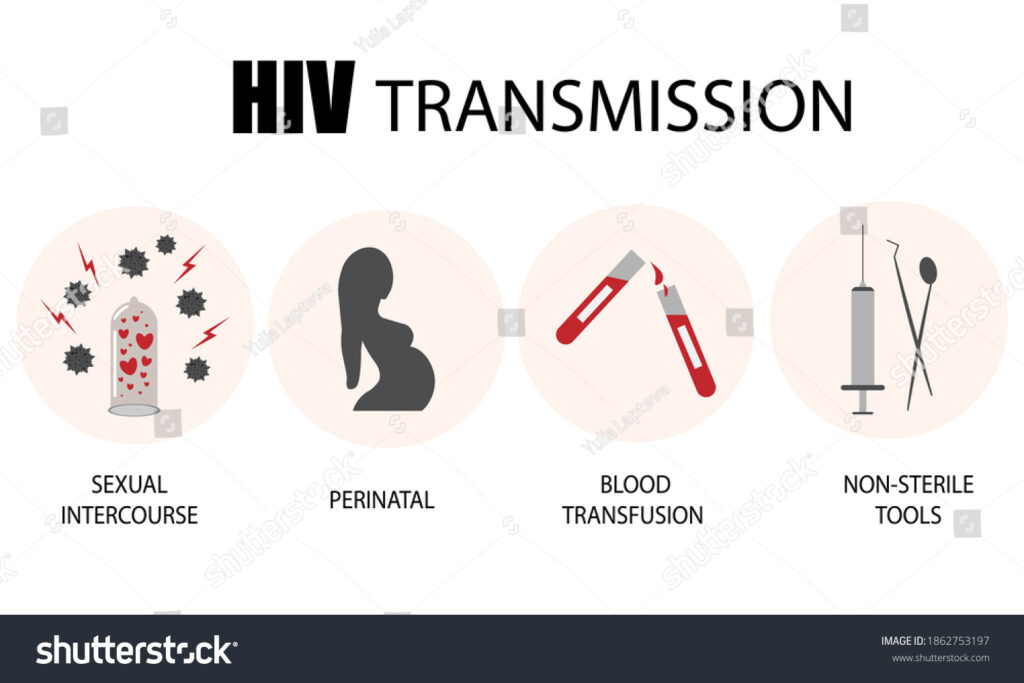How Can You Get HIV? Understanding the 4 Main Transmission Routes
Share IT

Launch Your Dream Website with Us!
Click Here to Get in touch with Us.
Categories
HIV transmission
Recognising the Routes of HIV Transmission
The Human Immunodeficiency Virus, or HIV, can be a scary subject. However, power comes from knowledge! To protect others as well as yourself, it is essential to understand how HIV is spread. The four primary methods of HIV transmission—sexual, perinatal, bloodborne, and needle-sharing—are examined in this blog post.
Thank you for reading this post, don't forget to subscribe!Table of Contents

Closeness and Danger: HIV Sexual Transmission
In the world, sexual contact is the most frequent way that HIV is spread. This is how it could happen:
- Unprotected vaginal, anal, or oral intercourse: In unprotected sex, the mucous membranes (tissues lining the inside of the mouth, rectum, or vagina) of the uninfected partner may come into touch with infected body fluids such as semen, vaginal fluid, and blood. This facilitates the virus’s entry into the bloodstream.
- Viral load: The quantity of HIV present in an infected person’s blood or body fluids, or the viral load, affects the risk of transmission. The chance of transmission rises with a greater viral load.
- Other sexually transmitted infections (STIs) present: HIV can more easily enter the circulation as a result of STIs such as syphilis, gonorrhoea, and bacterial vaginosis that cause open sores or inflammation in the vaginal tract.
It’s crucial to keep in mind that engaging in safe sexual behaviour can greatly lower the chance of HIV transmission during intercourse. This covers the proper and regular use of condoms as well as pre-exposure prophylaxis (PrEP) for high-risk individuals.
HIV Transmission from Mother to Child: Perinatal Transmission
HIV might potentially be passed from a woman who is positive to her kid during pregnancy, childbirth, or breastfeeding. Fortunately, this danger can be greatly reduced with appropriate medical care. Perinatal transmission can happen as follows:
- Pregnancy: During pregnancy, the virus can pass from mother to kid through the placenta.
- Childbirth: The infant may come into contact with contaminated blood or bodily fluids during a vaginal delivery.
- Breastfeeding: HIV can be passed from mother to child through breast milk if the mother is not receiving antiretroviral medication (ART).
Fortunately, the risk of perinatal transmission can be decreased to less than 1% with appropriate prenatal care, ART for the woman during her pregnancy and delivery, and safe newborn feeding practices (avoid nursing if the mother is not virally suppressed).
Bloodborne Transmission: Not Just Through Intercourse
HIV can also spread through blood contact with infected individuals. Here are a few ways that this might occur:
- Sharing syringes and needles: Sharing syringes or needles that have been contaminated when injecting narcotics or medication is an unsafe practice.
- Unintentional injuries from needle sticks: Personnel working in healthcare facilities or anyone else who might come into contact with sharp objects or needles tainted with contaminated blood may be at danger. Nonetheless, the danger is negligible if appropriate safety measures are followed.
- Blood transfusions: Transfusions from an infected individual can spread HIV, although they are exceedingly uncommon in developed nations because of stringent blood screening protocols.
- donation of organs: While this danger is reduced by careful screening, organ donation from an infected donor can also spread HIV.
It’s crucial to understand that HIV cannot be spread through casual contact with an infected individual. There is no risk involved with practices like hugging, sharing utensils, or using the same toilet.
Sharing Needles and Using Injectable Drugs is a Dangerous Habit
HIV is mostly spread through sharing needles and syringes used for drug injection, especially among injecting individuals (PWID). This is the reason why:
- Contaminated blood: Sharing syringes and needles spreads the virus directly into the bloodstream by allowing any infected blood still in the equipment to be shared.
- Increased risk-taking: Drug use can affect judgement and cause people to engage in unsafe sexual behaviour, which raises the possibility of HIV transmission even more.
In order to stop HIV transmission among PWID, harm reduction initiatives that include clean needles and syringes, in addition to addiction treatment and support services, are essential.
Information Strengthens Defence
It’s critical to comprehend the HIV transmission channels in order to make wise judgements that will safeguard both you and other people. HIV transmission can be considerably decreased by using safe sexual practices, abstaining from sharing needles, and getting appropriate medical attention when pregnant. Recall that the first step in prevention is information.

Launch Your Dream Website with Us!
Click Here to Get in touch with Us.





























































Recent Comments